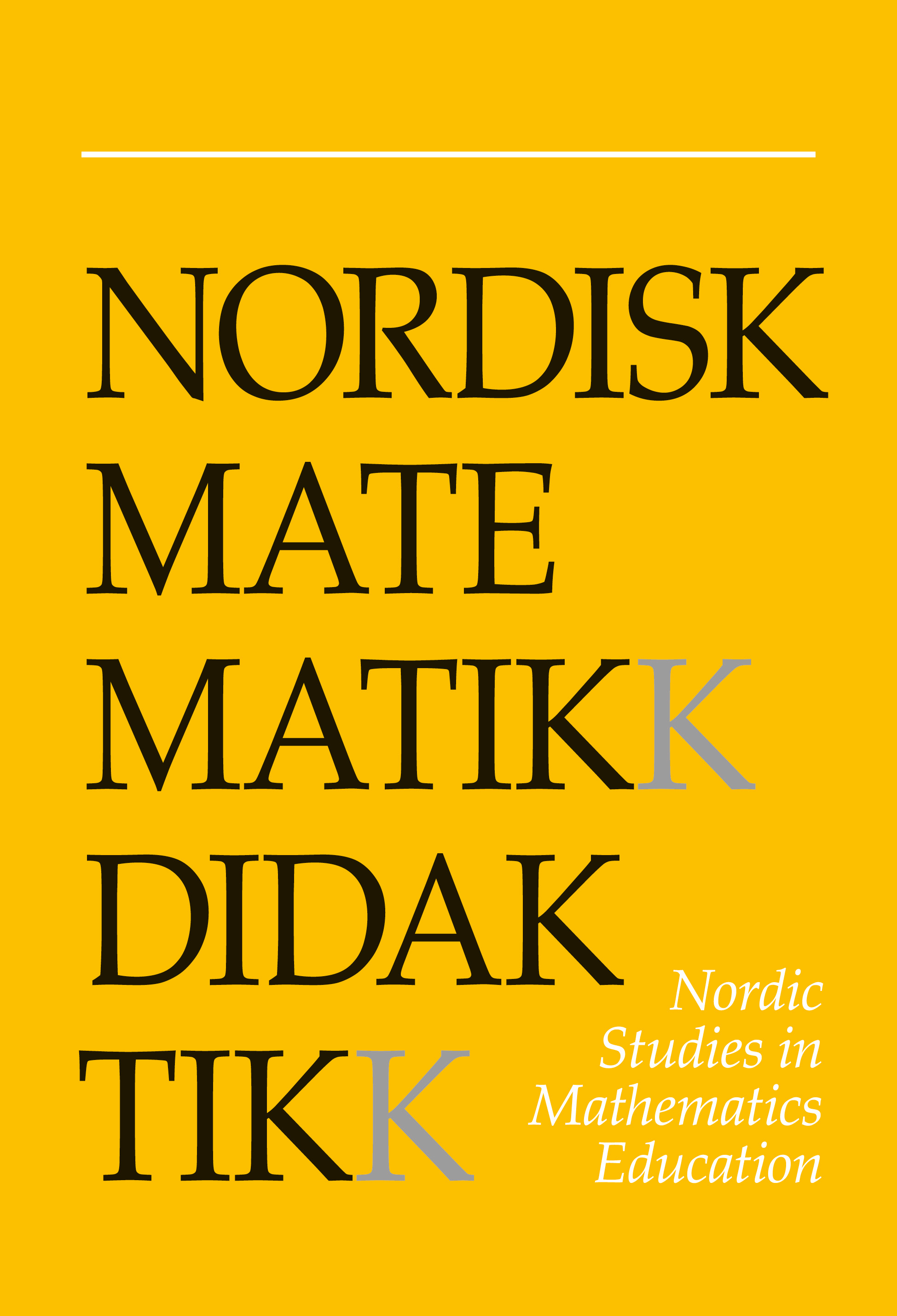The theory of conceptual change as a theory for changing conceptions
DOI:
https://doi.org/10.7146/nomad.v16i1-2.148290Abstract
It has become widely accepted that what and how mathematics teachers teach is linked to what it is they believe. What teachers believe, however, is not always in alignment with contemporary notions of mathematics and the teaching and learning of mathematics. As such, it is important for teacher educators to help facilitate changes in teachers’ beliefs in ways that will enable them to become more effective teachers of mathematics. In this article I present the results of a research project designed to examine the feasibility of using the theory of conceptual change as a theory for changing mathematics teachers’ conceptions about key aspects of mathematics and the teaching and learning of mathematics. The results indicate both that the theory of conceptual change is a viable theory for designing interventions for the purpose of changing beliefs, and that the implementation of these aforementioned interventions resulted in the rejection of participants’ a priori beliefs.
References
Ball, D. (1988). Unlearning to teach mathematics. For the Learning of Mathematics, 8 (1), 40-48.
Beswick, K. (2009). School mathematics and mathematicians' mathematics: teachers' beliefs about the nature of mathematics. In M. Tzekaki, M. Kaldrimidou & H. Sakonidis (Eds.), Proceedings of the 33rd annual conference of the International Group for the Psychology of Mathematics Education (Vol. 2, pp. 153-160). Thessaloniki: IGPME.
Brown, S. & Walter, M. (1983). The art of problem posing. Philadelphia: The Franklin Institute Press.
Chapman, O. (2002). Belief structures and inservice high school mathematics teacher growth. In G. Leder, E. Pehkonen & G. Törner (Eds.), Beliefs: a hidden variable in mathematics education (pp. 177-194). Dordrecht: Kluwer Academic Publishing. https://doi.org/10.1007/0-306-47958-3_11
Confrey, J. (1981). Conceptual change analysis: implications for mathematics curriculum. Curriculum Inquiry, 11, 243-257. https://doi.org/10.1080/03626784.1981.11075258
Fosnot, C. (1989). Enquiring teachers, enquiring learners: a constructivist approach for teaching. New York: Teachers College Press.
Green, T. (1971). The activities of teaching. New York: McGraw-Hill.
Greer, B. (2004). The growth of mathematics through conceptual restructuring. Learning and Instruction, 15 (4), 541-548. https://doi.org/10.1016/j.learninstruc.2004.06.018
Jaworski, B. (2006). Theory and practice in mathematics teaching development: critical inquiry as a mode of learning in teaching. Journal of Mathematics Teacher Education, 9 (2), 187-211. https://doi.org/10.1007/s10857-005-1223-z
Kuhn, T. (1970). The structure of scientific revolutions (second edition, enlarged), Chicago: The University of Chicago Press.
Lerman, S. (2001). Cultural and discursive psychology: a sociocultural approach to studying the teaching and learning of mathematics. Educational Studies in Mathematics, 46, 87-113. https://doi.org/10.1023/A:1014031004832
Lehtinen, E., Merenluoto, K. & Kasanen, E. (1997). Conceptual change from rational to (un)real numbers. European Journal of Psychology of Education, 12 (2), 131-145. https://doi.org/10.1007/BF03173081
Liljedahl, P. (2010). Noticing rapid and profound mathematics teacher change. Journal of Mathematics Teacher Education, 13 (5), 411-423. https://doi.org/10.1007/s10857-010-9151-y
Liljedahl, P. (2010). Rethinking assessment. Working group report of The Canadian Mathematics Education Forum, April 30-May 3, 2009, Vancouver, Canada.
Liljedahl, P., Rolka, K. & Rösken, B. (2007). Belief change as conceptual change. In D. Pitta-Pantazi & G. Philippou (Eds.), European research in mathematics education V. Proceedings of CERME5 (pp.278-287). Department of Education, University of Cyprus.
Lockhart, P. (2008). Lockhart's Lament. Retrieved on January 13, 2009 from: http://www.maa.org/devlin/LockhartsLament.pdf
Piaget, J. (1970). Genetic epistemology. New York: Columbia University Press. https://doi.org/10.7312/piag91272
Posner, G., Strike, K., Hewson, P. & Gertzog, W., (1982). Accommodation of a scientific conception: towards a theory of conceptual change. Science Education, 66, 211-227. https://doi.org/10.1002/sce.3730660207
Romagnano, L. (2001). Myth of objectivity in mathematics assessment. Mathematics Teacher, 94 (1), 31-37. https://doi.org/10.5951/MT.94.1.0031
Schommer-Aikins, M. (2004). Explaining the epistemological belief system: introducing the embedded systemic model and coordinated research approach. Educational Psychologist, 39 (1), 19-29. https://doi.org/10.1207/s15326985ep3901_3
Sfard, A. (2008). Thinking as communicating: human development, the growth of discourses, and mathematizing. New York: Cambridge University Press. https://doi.org/10.1017/CBO9780511499944
Simon, M. (1995). Reconstructing mathematics pedagogy from a constructivist perspective. Journal for Research in Mathematics Education, 26 (2), 114-145. https://doi.org/10.2307/749205
Skemp, R. R. (1978). Relational understanding and instrumental understanding. Arithmetic Teacher, 26 (3), 9-15. https://doi.org/10.5951/AT.26.3.0009
Skott, J. (2001). The emerging practices of novice teachers: the roles of his school mathematics images. Journal of Mathematics Teacher Education, 4 (1), 3-28. https://doi.org/10.1023/A:1009978831627
Steffe, L. (1991). The constructivist teaching experiment: illustrations and implications. In E. von Glasersfeld (Ed.), Radical constructivism in mathematics education (pp. 177-194). Dordrecht: Kluwer. https://doi.org/10.1007/0-306-47201-5_9
Streefland, L. (1993) The design of a mathematics course. A theoretical reflection. Educational Studies in Mathematics, 25 (1-2), 109-135. https://doi.org/10.1007/BF01274105
Streefland, L. (1985). Wiskunde als activiteit en de realiteit als bron. Nieuwe Wiskrant, 5 (1), 60 - 67.
Tirosh, D. & Tsamir, P. (2004). What can mathematics education gain from the conceptual change approach? And what can the conceptual change approach gain from its application to mathematics education? Learning and Instruction, 15 (4), 535-540. https://doi.org/10.1016/j.learninstruc.2004.06.017
Van den Heuvel-Panhuizen, M. (2003). The didactical use of models in realistic mathematics education: an example from a longitudinal trajectory on percentage. Educational Studies in Mathematics, 54, 9-35 https://doi.org/10.1023/B:EDUC.0000005212.03219.dc
Vosniadou, S. (2006). Mathematics learning from a conceptual change point of view: theoretical issues and educational implications. In J. Novotna, H. Moraova, M. Kratka & N. Stehlikova (eds.), Proceedings of 30th Annual Conference for the Psychology of Mathematics Education (Vol. 1, 163-165). Prague: Program Committee.
Downloads
Published
How to Cite
Issue
Section
License

This work is licensed under a Creative Commons Attribution-NonCommercial-ShareAlike 4.0 International License.



